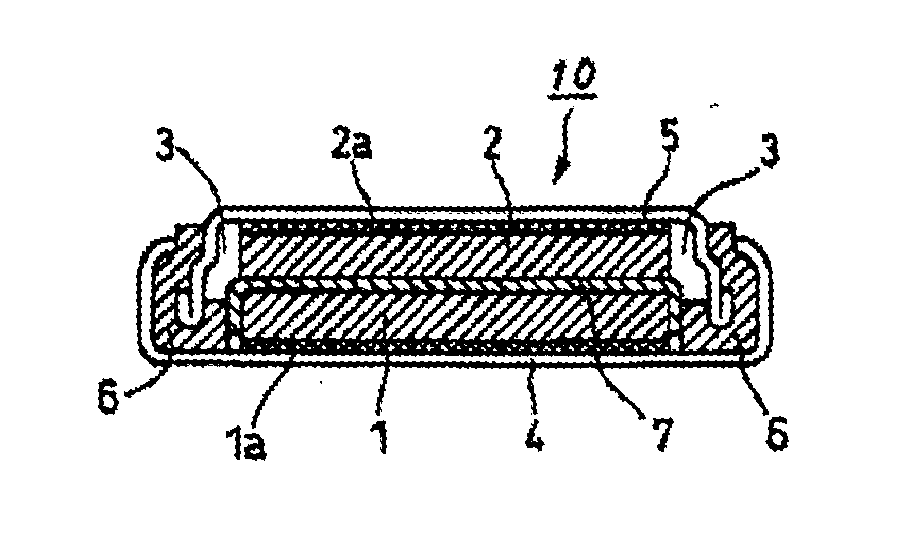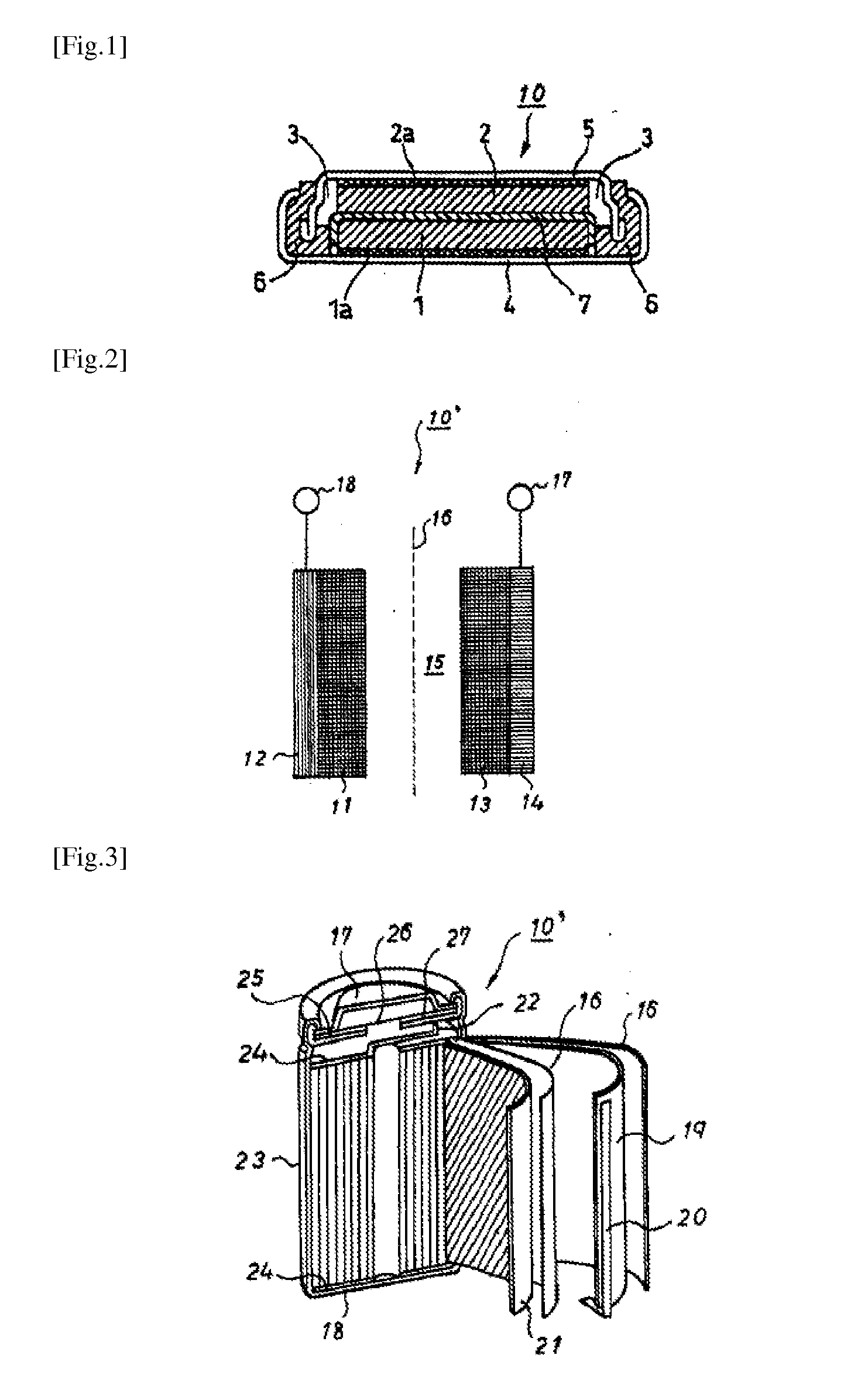Non-aqueous electrolyte secondary battery
a secondary battery and non-aqueous electrolyte technology, applied in the direction of electrochemical generators, cell components, transportation and packaging, etc., can solve the problems of low capacity of lithium secondary batteries, easy elution of manganese, and increased cost of cobalt as raw materials, and achieve small internal resistance and high electric capacity
Inactive Publication Date: 2013-09-12
ADEKA CORP
View PDF3 Cites 18 Cited by
- Summary
- Abstract
- Description
- Claims
- Application Information
AI Technical Summary
Benefits of technology
The present invention allows for a non-aqueous electrolyte secondary battery that uses lithium-containing metal oxide to have high electric capacity and low internal resistance even after storage at high temperatures and charging and discharging at high temperatures.
Problems solved by technology
Conventionally, lithium cobaltate has been widely used as a positive electrode active material in non-aqueous electrolyte secondary batteries, but the cost of cobalt as a raw material has been raising in recent years, and thus positive electrode active materials using inexpensive metal materials other than cobalt have been developed, and use of inexpensive positive electrodes using such positive electrode active materials has been rapidly prevailed.
Lithium-containing metal oxides that contain manganese are excellent in performance in view of the output of lithium secondary batteries, but are inexpensive, whereas they have a problem that elution of manganese easily occurs at a high temperature, and the capacities of lithium secondary batteries are decreased by repetitive use.
However, additives for non-aqueous electrolytes which have been conventionally known as those mentioned above could not exhibit a sufficient effect on a positive electrode containing a lithium-containing metal oxide that contains manganese as a positive electrode active material, and thus further improvement has been demanded.
Method used
the structure of the environmentally friendly knitted fabric provided by the present invention; figure 2 Flow chart of the yarn wrapping machine for environmentally friendly knitted fabrics and storage devices; image 3 Is the parameter map of the yarn covering machine
View moreImage
Smart Image Click on the blue labels to locate them in the text.
Smart ImageViewing Examples
Examples
Experimental program
Comparison scheme
Effect test
examples
[0099]Hereinafter the present invention will be explained in more detail by Examples and Comparative Examples. However, the present invention is not construed to be limited by the following Examples and the like. Unless otherwise indicated, the “part(s)” and “%” in Examples are on the mass basis.
the structure of the environmentally friendly knitted fabric provided by the present invention; figure 2 Flow chart of the yarn wrapping machine for environmentally friendly knitted fabrics and storage devices; image 3 Is the parameter map of the yarn covering machine
Login to View More PUM
| Property | Measurement | Unit |
|---|---|---|
| thickness | aaaaa | aaaaa |
| thickness | aaaaa | aaaaa |
| diameter | aaaaa | aaaaa |
Login to View More
Abstract
Provided is a non-aqueous secondary battery that uses a lithium-containing metal oxide that contains manganese as a positive electrode active material, and wherein a small internal resistance and a high electric capacity can be maintained even after high-temperature storage or charge and discharge at high temperatures, by suppressing elution of manganese from the positive electrode active material. Specifically provided is a non-aqueous electrolyte secondary battery with a negative electrode capable of intercalating and deintercalating lithium ions, a positive electrode with a lithium-containing compound as the positive electrode active material, and a non-aqueous electrolyte that has lithium salt dissolved in an organic solvent. Said non-aqueous electrolyte secondary battery is characterized by the lithium-containing compound being a lithium-containing metal oxide compound that contains manganese and by the non-aqueous electrolyte containing a fluorosilane compound indicated by general formula (1). (In the formula, R1 to R3 independently represent an alkyl group having 1 to 8 carbon atoms, an alkenyl group having 2 to 8 carbon atoms, a cycloalkyl group having 5 to 8 carbon atoms, an aryl group having 6 to 8 carbon atoms, or a fluorine atom, and R4 represents an alkylene group having 1 to 8 carbon atoms or an alkylene group having 4 to 8 carbon atoms and having an ether group.)
Description
TECHNICAL FIELD[0001]The present invention relates to a non-aqueous electrolyte secondary battery, and specifically relates to a non-aqueous electrolyte secondary battery having a positive electrode containing a lithium-containing metal oxide that contains manganese as a positive electrode active material, and a non-aqueous electrolyte containing a specific fluorosilane compound.BACKGROUND ART[0002]In accordance with the widespread use of portable electronic devices such as portable personal computers, handy video cameras and information terminals in recent years, non-aqueous electrolyte secondary batteries having a high voltage and a high energy density have been widely used as power sources. Furthermore, in view of environmental problems, battery automobiles and hybrid automobiles utilizing electrical power as a part of the power thereof have been put into practical use.[0003]In non-aqueous electrolyte secondary batteries, various additives for non-aqueous electrolytes have been s...
Claims
the structure of the environmentally friendly knitted fabric provided by the present invention; figure 2 Flow chart of the yarn wrapping machine for environmentally friendly knitted fabrics and storage devices; image 3 Is the parameter map of the yarn covering machine
Login to View More Application Information
Patent Timeline
 Login to View More
Login to View More Patent Type & Authority Applications(United States)
IPC IPC(8): H01M10/0564H01M10/052
CPCH01M4/505H01M10/0525H01M10/0567H01M10/0564Y02E60/122H01M10/052Y02T10/7011Y02E60/10Y02T10/70
Inventor TAKI, TAKAYUKIOHNUMA, YUYUSHIBUYA, ATSUKIWATANABE, HIROAKI
Owner ADEKA CORP
Features
- R&D
- Intellectual Property
- Life Sciences
- Materials
- Tech Scout
Why Patsnap Eureka
- Unparalleled Data Quality
- Higher Quality Content
- 60% Fewer Hallucinations
Social media
Patsnap Eureka Blog
Learn More Browse by: Latest US Patents, China's latest patents, Technical Efficacy Thesaurus, Application Domain, Technology Topic, Popular Technical Reports.
© 2025 PatSnap. All rights reserved.Legal|Privacy policy|Modern Slavery Act Transparency Statement|Sitemap|About US| Contact US: help@patsnap.com



